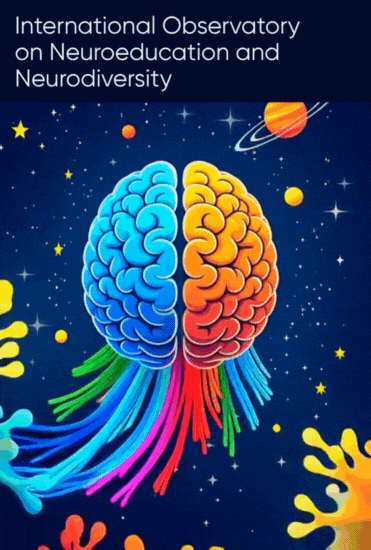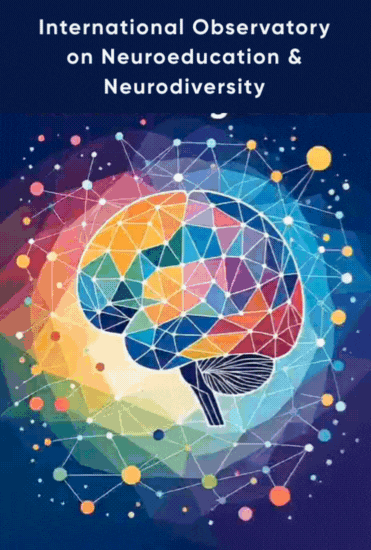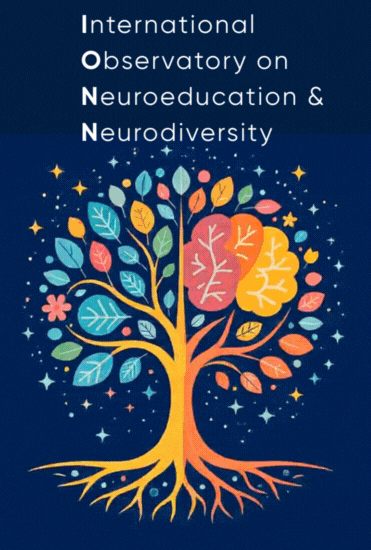NeuroAdvances®
Advances in Applied Neuroscience and Inclusive Education
The Observatory's publishing platform for researchers, educators, and professionals who wish to share advancements, experiences, and innovative proposals.


Our Publishing House
NeuroAdvances® emerges under the direction of the Editorial Board of the International Observatory of Neuroeducation and Neurodiversity as its academic, scientific, and outreach arm. Our purpose is to give voice and form to research, reflections, and proposals that strengthen the understanding of the human brain, educational processes, and neurological diversity in all its expressions.
Aims and Purpose
The primary aim of NeuroAdvances Publishing House is to create and disseminate rigorous and accessible knowledge that inspires the educational, scientific, and social community to promote inclusive and evidence-based practices. We aspire to be a bridge between cutting-edge research and its practical application in classrooms, institutions, families, and community spaces.
Objectives
Publish academic and popular science works that address neuroeducation, neurodiversity, and the contemporary challenges of inclusive education.
Support the intellectual production of specialists and professionals committed to innovation and educational equity.
Promote practical materials that serve as guides, manuals, and accessible pedagogical resources for educators, families, and students.
Increase the visibility of emerging authors in the field of applied neuroscience in education and the voices of the neurodivergent community itself.
Generate a positive social impact through publications that inspire understanding, empathy, and educational transformation.
Editorial Philosophy
Our philosophy is based on three pillars:
Science with Human Sense: All knowledge must respond to the real needs of individuals and communities.
Diversity as a Resource: We understand neurodivergence as a natural and valuable manifestation of the human condition.
Accessibility and Clarity: We strive for our publications to be understandable and useful for both specialists and the general public.
Types of Materials
Academic Books: Research, essays, and scientific compilations.
Practical Manuals and Pedagogical Guides: Tools for educators, therapists, and families.
Journals and Thematic Notebooks: Periodical publications with research articles, interviews, and classroom experiences.
Audiovisual and Multimedia Material: Digital resources, podcasts, short segments, and explanatory videos.
Inclusive Publications: Accessible formats (easy-to-read, audiobooks, braille, and visual materials).
Who We Address
Our editorial work is designed for:
Teachers and school administrators.
Researchers and university students.
Families of neurodivergent individuals.
Educational institutions and social organizations.
The general public interested in education, well-being, and neurosciences.
Our Commitment
NeuroAdvances Publishing House is committed to maintaining high standards of academic quality and ethics, promoting interdisciplinary collaboration and respect for diverse voices. Every publication is a step toward building a more just, empathetic, and conscious society that recognizes the value of neurodiversity.
Editorial Regulations
1. Mission and Scope
1.1. Mission: To publish high-quality original research, systematic reviews, and theoretical essays that explore the intersection between neuroscience, education, and the promotion of neurodiversity and inclusion.
1.2. Thematic Scope: Neuroeducation, Neurodiversity (ASD, ADHD, dyslexia, etc.), Evidence-Based Didactics, Cognitive and Emotional Development, Neuropsychological Assessment in Education, Inclusive Education Policies and Practices, and Supportive Technologies (EdTech) for diverse learning.
1.3. Audience: Researchers, academics, education professionals (teachers, educational psychologists), neuroscientists, therapists, and educational policymakers.
2. Editorial Structure and Governance
2.1. Editorial Board Composition: The Board will consist of an Editor-in-Chief, Associate Editors, and an International Advisory or Consulting Board.
2.2. Board Presidency: The Editorial Board will be chaired by the Director General of the International Observatory of Neuroeducation and Neurodiversity. Their function will be to oversee the strategic vision, overall ethics, and fulfillment of the journal's mission.
2.3. Responsibility: The Editorial Board holds the ultimate responsibility for scientific quality, editorial decision-making, and promoting research integrity.
3. Ethics and Best Editorial Practices
3.1. Ethical Adherence: The journal adheres to the guidelines of the Committee on Publication Ethics (COPE).
Integrity and Originality: Manuscripts must be original, must not have been previously published, and must not be under simultaneous review elsewhere (except as a pre-print).
Authorship: Limited to those who have made a substantial intellectual contribution to the study. A declaration of each author's contribution must be attached.
Conflicts of Interest (COI): All authors, reviewers, and Editorial Board members must declare any financial or personal COI.
3.2. Consent and Protection of Subjects: If the study involves human subjects, it is mandatory to attach approval from the Institutional Ethics Committee and a statement confirming the participants' informed consent, ensuring confidentiality.
3.3. Plagiarism Detection: All manuscripts will be subjected to plagiarism detection software. Cases of plagiarism or data manipulation will result in immediate rejection.
4. Peer Review Process
4.1. Modality: The Double-Blind Peer Review system will be used.
4.2. Process:
Initial Editor Review: Preliminary review for scope suitability and compliance with guidelines.
Reviewer Assignment: The manuscript is sent to a minimum of two (2) independent experts.
Decision: Based on the reviewers' reports. Options are: Accept, Accept with Minor Revisions, Reconsider After Major Revisions, or Reject.
Timeline: The goal is to communicate the first decision within a maximum of 8 to 12 weeks.
5. Manuscript Structure and Format
5.1. Contribution Types: Original Research Article, Review Article (Systematic or Narrative), Theoretical Essay/Reflection, Research Protocol, and Book Reviews.
5.2. General Format:
Length: A word limit will be established (e.g., 6,000–8,000 words for original articles).
Citation Style: The APA (American Psychological Association) style in its latest edition will be adopted.
Structure: Original articles must follow the IMRAD structure (Introduction, Method, Results, and Discussion).
Language: Manuscripts will be accepted in Spanish and English.
5.3. Key Requirements:
Structured Abstract: Maximum 250 words with clear sections (Objective, Method, Results, Conclusion).
Keywords: Minimum 3, Maximum 5.
6. Access and Dissemination Policies (Open Access)
6.1. Publication Model: The journal will operate under a full Open Access model, guaranteeing free availability and exchange of content.
6.2. Copyright: Authors will retain the copyright of their work. Articles will be published under a Creative Commons (CC BY-NC 4.0) license, allowing non-commercial use, distribution, and reproduction, provided proper citation is given.
6.3. Archiving and Preservation: The journal will ensure digital preservation by depositing its content in recognized national and international repositories and databases (e.g., Latindex, Redalyc, DOAJ).
7. Fees (Article Processing Charges - APCs)
7.1. Fee Policy: To sustain the high-quality Open Access model and cover costs for layout, hosting, and management, an Article Processing Charge (APC) will apply once the manuscript has been formally accepted for publication.
7.2. Waivers: A waiver policy will be established for authors from developing countries or those demonstrating insufficient funds, ensuring that peer review is not contingent on payment.
Aproved version dated September 1, 2025


Actualidad
info@observaneuro.com
The International Observatory of Neuroeducation and Neurodiversity® its logo, and slogans constitute industrial property and are either registered or may be in the process of registration with the relevant authorities. Therefore, any unauthorized reproduction thereof by any means is strictly prohibited.
© International Observatory of Neuroeducation and Neurodiversity 2025. All rights reserved.


Privacy Policy
